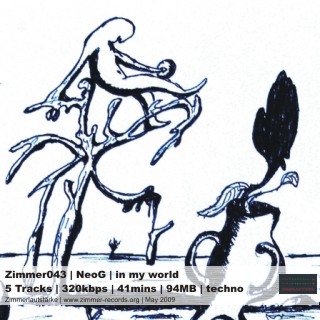Zimmer043 – NeoG – in my world (hungary)
mp3, 320kbps, stereo, techno, trance
043.01 – NeoG – Deep Inside
043.02 – NeoG – Electronic Anthem
043.03 – NeoG – Virtual Fantasy
043.04 – NeoG – Tribal Life
043.05 – NeoG – Princess Bridget
download & stream -> archive.org
download & stream -> sonicsquirrel
download & stream -> last.fm
download ZIP (MP3 | 91MB)
Artwork (666px)
[by nadrealizam]
In philosophy, the World is everything that makes up reality. While clarifying the concept of world has arguably always been among the basic tasks of Western philosophy, this theme appears to have been raised explicitly only at the start of the twentieth century and has been the subject of continuous debate. The question of what the world is has by no means been settled.
The traditional interpretation of Parmenides’ work is that he argued that the every-day perception of reality of the physical world (as described in doxa) is mistaken, and that the reality of the world is ‘One Being’ (as described in aletheia): an unchanging, ungenerated, indestructible whole.
In his Allegory of the Cave, Plato distinguishes between forms and ideas and imagines two distinct worlds : the sensible world and the intelligible world.
In Hegel’s philosophy of history, the expression Weltgeschichte ist Weltgericht (World History is a tribunal that judges the World) is used to assert the view that History is what judges men, their actions and their opinions. Science is born from the desire to transform the World in relation to Man; its final end is technical application.
The World as Will and Representation is the central work of Arthur Schopenhauer. Schopenhauer saw the human will as our one window to the world behind the representation; the Kantian thing-in-itself. He believed, therefore, that we could gain knowledge about the thing-in-itself, something Kant said was impossible, since the rest of the relationship between representation and thing-in-itself could be understood by analogy to the relationship between human will and human body.
Two definitions that were both put forward in the 1920s, however, suggest the range of available opinion. “The world is everything that is the case,” wrote Ludwig Wittgenstein in his influential Tractatus Logico-Philosophicus, first published in 1922. This definition would serve as the basis of logical positivism, with its assumption that there is exactly one world, consisting of the totality of facts, regardless of the interpretations that individual people may make of them.
Martin Heidegger, meanwhile, argued that “the surrounding world is different for each of us, and notwithstanding that we move about in a common world”. The world, for Heidegger, was that into which we are always already “thrown” and with which we, as beings-in-the-world, must come to terms. His conception of “world disclosure” was most notably elaborated in his 1927 work Being and Time.
In response, Sigmund Freud proposed that we do not move about in a common world, but a common thought process. He believed that all the actions of a person are motivated by one thing: lust. This led to numerous theories about reactionary consciousness.
Some philosophers, often inspired by David Lewis, argue that metaphysical concepts such as possibility, probability and necessity are best analyzed by comparing the world to a range of possible worlds; a view commonly known as modal realism. //wikipedia
